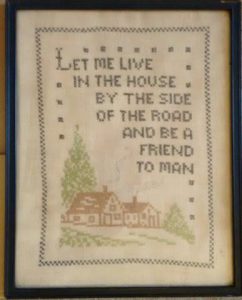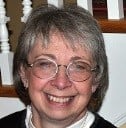 When my brother was little (long ago and not far away), he would lull himself to sleep by reciting the phrase on an antique cross-stitched sampler of a house which hung on the wall over his bed: “Let me live in a house by the side of the road and be a friend to man.” This simple sampler makes me think about how many things change yet remain the same in my neighborhood.
When my brother was little (long ago and not far away), he would lull himself to sleep by reciting the phrase on an antique cross-stitched sampler of a house which hung on the wall over his bed: “Let me live in a house by the side of the road and be a friend to man.” This simple sampler makes me think about how many things change yet remain the same in my neighborhood.
I have come to understand that my family history is intrinsically linked to the houses my ancestors built as well as the area in which they built them, two inseparable elements which complement each other, and which provide fodder for my “family stories.” However, neighborhood nuances can’t be found in official documents. Later census records list household members with street addresses, but no census gives obvious revelations as to the character and personality of the people or their neighborhoods. We travel past historic places every day without really seeing or thinking about them or their builders.
My Old House where we grew up sits by the side of the road (a bit too close according to some realtors). Our ancestor, Asa Williams, a Revolutionary War veteran, finished building it in 1789 on something less than a road. Old maps show the most traveled path was along the riverbank, a few hundred yards east of the house. Eventually travel to the settlers’ houses along the high side of the riverbank created the road more or less in its current location, subject to the evolution of contemporary vehicles (horses morphed into gravel trucks, thank you Henry Ford).
Many of those houses still stand, including my great-great-great-great-grandfather’s 1789 house next door, and many are occupied by descendants of the original homeowners. Many of the family names on early maps, tax records, town records, and church records are the same names on mailboxes on this road today – Church, Cony, Williams, Saunders, Fisher, Fletcher, Sawtelle, Howard. From personal stories, old local histories, diaries, and the odd manuscript, I’ve found that this is a neighborhood of centuries of families interacting, intermarrying, interweaving, and maintaining its history in the midst of change.
Asa Williams was a founder of the first Meeting House and the appointed tythingman. He was nearby in July 1806 when Capt. James Purrington did his Lizzie Borden thing to his wife and six children, not far from My Old House. Midwife Martha Ballard lived nearby and was a frequent visitor here. Nephew Reuel Williams became U.S. Senator Williams. Great-nephew Seth Williams became a distinguished Civil War Union general. Charles Saunders grew plums in my backyard, and Lora Packard Saunders, a great-great-great-great-great-great-granddaughter of John and Priscilla (Mullins) Alden, sold the property to her cousins, my parents.
My father remembered a few members of the Passamaquoddy tribe traveling by in the 1930s, offering to help on the farm in return for a few dollars or a few meals; they never left empty-handed. The fishmonger of my childhood came by in his truck, the bed of which was filled with cracked ice and loaded with his day’s catch; he always left with less. In 1946 two young men from Indiana spent the summer bicycling to Maine where they shingled our house roof and played catch with my brother (they took a bus home!). The Fuller Brush man came to the house for his entire 50-year career, selling products to three generations of my family. My father was the milkman who met my mother when he delivered milk to her landlady. Today, the milkman, the fishmonger, and the itinerant workers have given way to box stores and the internet, and the Fuller Brush salesman has retired.
These were some of the famous and infamous of past times, living and working next to Everyman in the neighborhood and community. Whether they lived in the neighborhood or passed through it, all manner of men and women made up this neighborhood. Now, the “incomers” (as we all once were), be they from other cities, countries, or states, signal a change already underway. Today we have businessmen, city councilors, farmers, retirees, disabled, teachers, writers (!), and more, law-abiding and not, educated and not, with widely varying ethnicities. The ancestors of these neighborhood people were as diverse as our population is now. However good or bad, foolish or wise, weak or strong, misguided or sensible, our people make families who make neighborhoods who make communities who make a history not to be ignored but to be remembered, understood, and appreciated.
"The House By the Side of the Road" by Sam Walter Foss (1858–1911)
Let me live in my house by the side of the road
Where the race of men go by–
They are good, they are bad, they are weak, they are strong,
Wise, foolish – so am I.
Then why should I sit in the scorner’s seat
Or hurl the cynic’s ban?
Let me live in my house by the side of the road
And be a friend to man.
Share this:

About Jan Doerr
Jan Doerr received a B.A. degree in Sociology/Secondary Education from the University of New Hampshire, and spent a long career in the legal profession while researching her family history. She has recently written and published articles for WBUR.org’s Cognoscenti blog: “Labor of Love: Preserving a 226-Year-Old Family Home and Preparing to Let It Go” and “The Value of Family Heirlooms in a Digital Age.” Jan currently lives with her attorney husband in Augusta, Maine, where she serves two Siamese cats and spends all her retirement money propping up a really old house.View all posts by Jan Doerr →